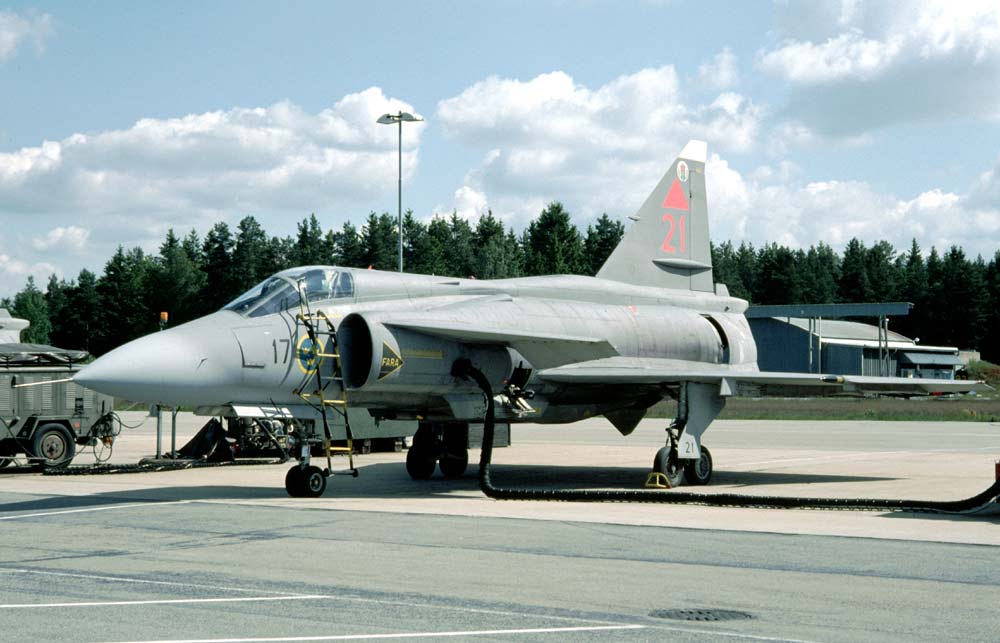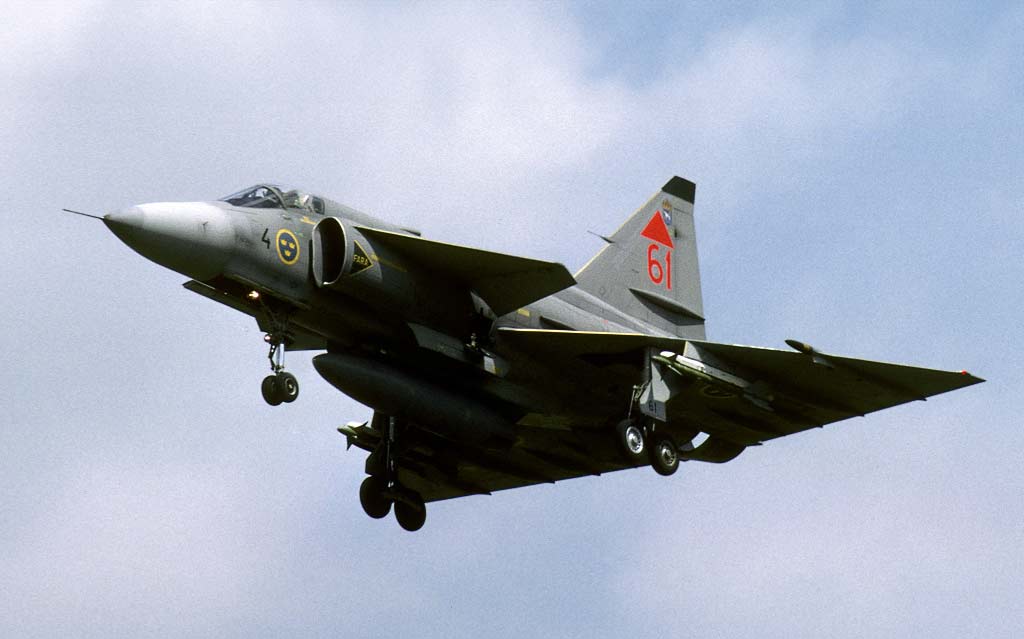The Saab JA37 Viggen is a Swedish multirole fighter known for its delta wing, canard design, and thrust reverser capabilities.
In brief
The Saab JA37 Viggen, a Swedish-engineered multirole combat aircraft, was a prominent figure in the Cold War era, showcasing advanced aerodynamics with its delta wing and canard configuration. Equipped with a powerful Volvo RM8 turbofan and a sophisticated avionics suite, it excelled in air-to-air and air-to-surface missions. Notable for its short takeoff and landing capabilities, the Viggen could operate from austere bases and highways, enhancing its tactical flexibility. Its design incorporated a thrust reverser, allowing it to land on short airstrips, a unique feature among fighters of its time.

History of the Development of the Saab JA37 Viggen (Thunderbolt)
The Saab JA37 Viggen, developed by Saab AB, was a product of Sweden’s nuanced defense needs during the Cold War, designed to perform various roles, including air defense, reconnaissance, and ground attack. In the 1960s, Sweden sought a versatile aircraft to replace its aging fleet of subsonic fighters and interceptors. The objective was clear: a jet capable of operating from short runways, withstanding harsh weather, and embodying Sweden’s doctrine of defensive independence, necessitating the ability to engage in both interception and ground-attack missions effectively.
Launched by Saab in the late 1960s, the Viggen’s development was a statement of Sweden’s advanced industrial capabilities, featuring pioneering avionics and aerodynamics. The JA37 variant, specifically tuned for the air-to-air role, first flew on 27 February 1974. It was a testament to Swedish engineering, designed to meet the demands of Sweden’s unique strategic doctrine, which emphasized versatility, adaptability, and the ability to operate independently of foreign support.
The NATO reporting name for earlier Viggen variants was “Thunderbolt,” but the JA37 typically did not carry this nickname. The Viggen was crafted during a period when international tensions dictated a strong national defense, and Sweden’s policy of neutrality necessitated a capable, technologically advanced air force.
Design of the Saab JA37 Viggen (Thunderbolt)
The design of the JA37 Viggen was revolutionary, combining a delta wing with canards to provide excellent high-speed and low-speed performance, crucial for its intended multirole capabilities. This configuration offered significant lift and maneuverability, critical for both air-to-air combat and ground attack missions. The aircraft was powered by the Volvo RM8 turbofan, a license-built variant of the Pratt & Whitney JT8D, enhanced with an afterburner and a thrust reverser, enabling it to operate from short and improvised airstrips.
Advanced avionics were central to the Viggen, incorporating radar, head-up display, and onboard computers, which were cutting-edge at the time. It was one of the first aircraft to feature a computer with integrated circuits, enabling complex missions and reducing pilot workload.
However, the sophisticated design also meant the aircraft was complex and expensive to maintain. The use of afterburners increased fuel consumption, affecting the aircraft’s range and endurance. Despite these drawbacks, the Viggen’s innovative features, like its thrust reverser and short take-off and landing capability, gave it a unique operational flexibility, particularly in the dispersed basing strategy adopted by Sweden during the Cold War.
Performance of the Saab JA37 Viggen (Thunderbolt)
The JA37 Viggen’s performance was impressive, characterized by its high thrust-to-weight ratio and advanced aerodynamics. The Volvo RM8 engine, producing up to 16,200 pounds of thrust with afterburner, allowed the aircraft to reach speeds over Mach 2. The Viggen’s delta wing and canard design provided excellent maneuverability and stability at various speeds and altitudes, suitable for both high-altitude intercepts and low-level flight.
It boasted a service ceiling above 50,000 feet and could engage targets at long range thanks to its sophisticated PS-37/A radar, capable of multiple target tracking and engagement. The aircraft’s range was substantial, further enhanced by in-flight refueling capabilities introduced in later models. Comparatively, the Viggen held its own against contemporaneous Western fighters like the F-15 Eagle and F-16 Fighting Falcon, particularly in its ability to operate from austere bases and its versatility across different mission profiles.
Variants of the Saab JA37 Viggen (Thunderbolt)
The Viggen family included several variants, each designed for specific roles:
- AJ37: The initial attack version, optimized for ground-attack and maritime strike roles.
- SF37: A dedicated photo-reconnaissance variant, featuring specialized cameras and sensors.
- SH37: The maritime surveillance/anti-ship model, equipped with anti-ship missiles and maritime reconnaissance equipment.
- SK37: A two-seat trainer version, modified from the AJ37 to provide training with full combat capability.
- JA37: The definitive air defense variant, upgraded with advanced avionics, improved radar, and air-to-air missile capabilities.
Each variant was tailored to fulfill specific requirements of the Swedish Air Force, ensuring that the Viggen could perform a wide range of missions effectively. The JA37, in particular, represented the pinnacle of the Viggen’s development, incorporating the most advanced technology and capabilities for air superiority and interception roles.

Military Use and Combat of the Saab JA37 Viggen (Thunderbolt)
The Saab JA37 Viggen, primarily serving the Swedish Air Force, was not engaged in actual combat operations, reflecting Sweden’s longstanding policy of neutrality. However, its military significance was profound, acting as a key component of Sweden’s air defense strategy throughout its service life. The aircraft was regularly updated to meet evolving threats, showcasing its adaptability in various military exercises and readiness to defend Swedish airspace.
The Viggen’s armament for the JA37 variant included the advanced RB71 (AIM-120 AMRAAM in later years) air-to-air missiles, complemented by shorter-range Sidewinders and a 30 mm Oerlikon cannon, making it a formidable opponent in air-to-air combat. It was also equipped with sophisticated electronic warfare systems to enhance its survivability in hostile environments.
Though it never saw combat, the Viggen was a vital part of NATO’s northern flank defense, participating in numerous joint exercises and showing its capabilities in simulated air combat and ground-attack scenarios. Its performance in these exercises demonstrated its effectiveness against contemporary threats and its potential in a real-world conflict, matching or even surpassing the capabilities of similar-era fighters like the F-4 Phantom II and mirroring the advancements seen in the F-16 Fighting Falcon.
The Viggen was phased out of service in the early 2000s, replaced by the more advanced Saab JAS 39 Gripen, which offered better performance, lower operating costs, and modernized capabilities aligned with contemporary air warfare requirements. The transition to the Gripen marked the end of the Viggen’s era but the aircraft remains celebrated for its technological advancements and significant contribution to Swedish and international aerospace engineering.
The Saab JA37 Viggen represents a significant milestone in military aviation, particularly in the context of Cold War aerospace development. Its innovative design, characterized by the distinctive delta wing and canard configuration, combined with state-of-the-art avionics, made it one of the most advanced fighters of its time. The Viggen’s ability to operate from dispersed and rudimentary bases using its unique thrust reverser system set it apart from its contemporaries and demonstrated Sweden’s independent defense capability ethos.
While the JA37 variant was specifically optimized for air defense, the Viggen family as a whole showcased remarkable versatility across multiple roles, from ground attack to maritime reconnaissance. Its development mirrored the technological leaps of the era, pushing the boundaries of what was possible in combat aircraft design and capability.
Although the Viggen has since retired from active service, its legacy endures in the principles of versatility, reliability, and self-sufficiency it embodied—principles that continue to influence modern combat aircraft design, particularly in Sweden’s subsequent fighter, the Saab JAS 39 Gripen. The Viggen not only served as a cornerstone of Swedish defense but also as a testament to the innovation and engineering prowess of the Swedish aerospace industry.
Back to the Fighter Jet section.